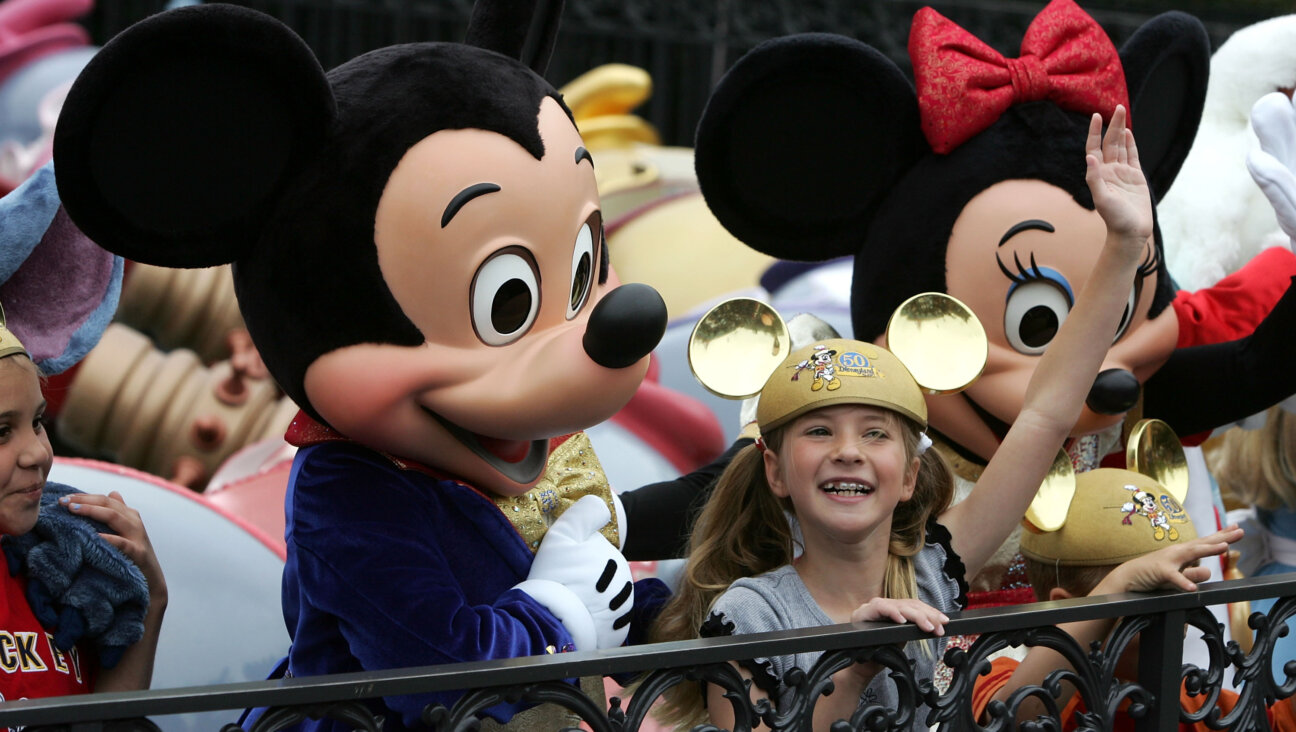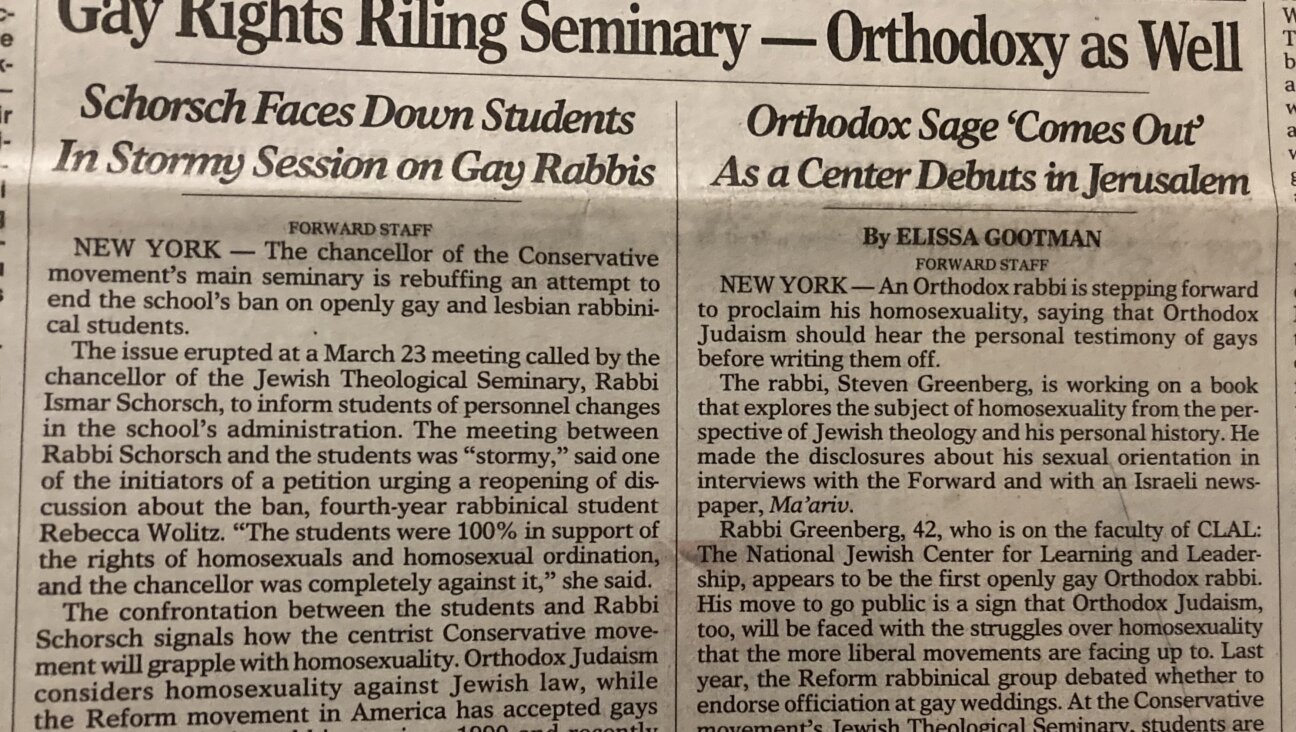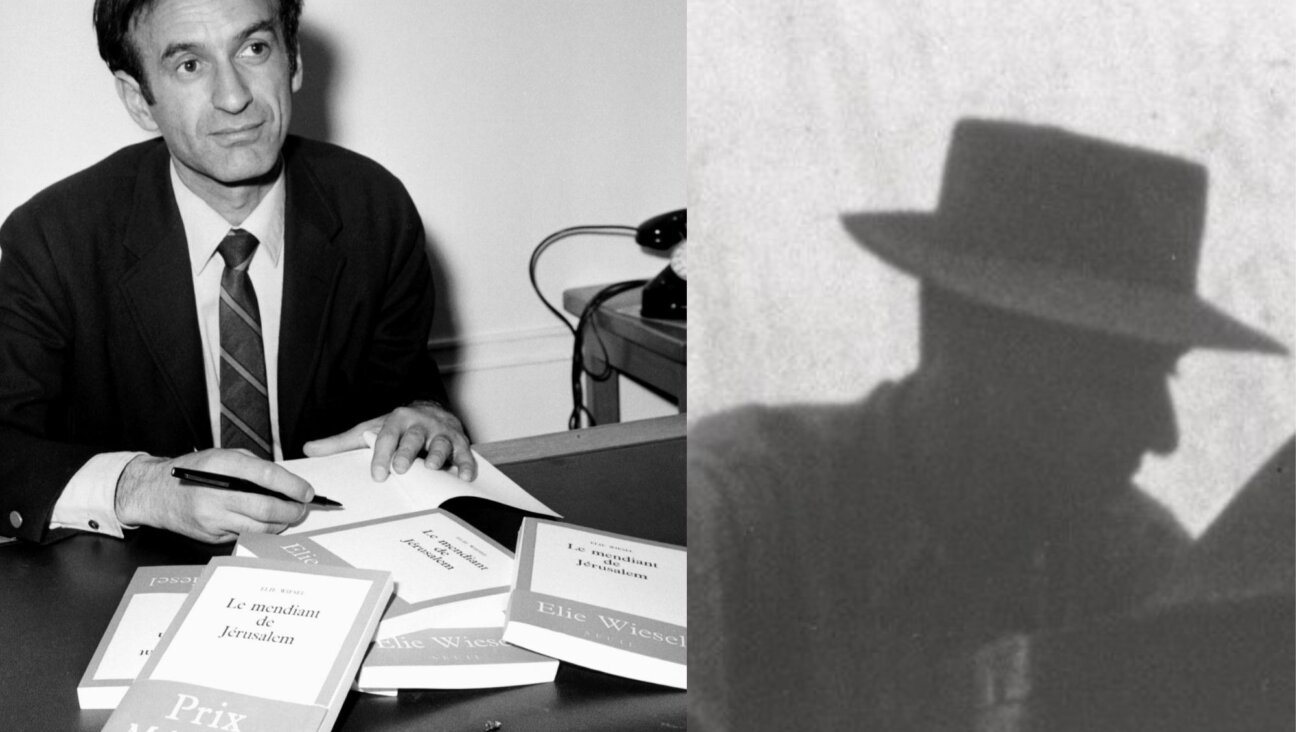We’re here, we’re queer, we’re Yiddish: LGBTQ stories, and silences, in the Forward archives

David Carey, Yiddish theater impresario, in front of New York’s Town Hall. Courtesy of Forward Association
It’s traditional for the gay community to gather for brunch before a Pride march during Pride month, or nachas khoydesh in Yiddish.
Today, we propose instead a forshpayz, an appetizer-sized portion of queer archival Forverts history — rare treasures celebrating LGBTQ dignity, visibility and equality: our first archival Pride march back in time.
For me, it’s a march that’s deeply meaningful — and also fraught.
As a young Jewish lesbian, I came out in the 1980s to the beat of the second National March on DC for LGBTQ rights, and the massive NAMES project quilt celebrating the lives of those lost to the AIDS pandemic. I lived on San Francisco’s gayest Castro Street, in a communal apartment above the Castro Street Station, one of many popular gay bars that were community gathering spots, especially on Friday nights.

Forward archivist Chana Pollack. Courtesy of Yiddish Book Center
I fell asleep to the bar’s throbbing disco beat below my futon, my head beneath a Jewish poster about AIDS that spoke of vast complicit silences and histories lost to shame. “Who will say kaddish for me?” it asked, referring to those dying of AIDS who were refused Jewish pastoral care on even the most basic level.
It also spoke to those of us who couldn’t hope to ever bring our whole gay selves, let alone our partners, home to the mishpokhe.
As a Jewish feminist lesbian from a Modern Orthodox background, I completely identified.
In my two decades as the Forward’s archivist, I’ve gone searching for historical coverage of the LGBTQ community. Despite the paper’s reputation as the “address of the Jewish people,” and rumors that one of the Sunday illustrated issue’s editors himself was gay, queer Jewish lives were only infrequently featured on our pages. They’re not likely to be found chronicled in any of our sepia-toned images or our captions about shtetl life, and they’re officially missing from photos and stories of family circle get-togethers and obituaries.
If they’re mentioned at all in the Forward’s century of serialized fiction, news reporting, beloved Bintel Brief advice column and proud social justice and labor updates, it’s likely deeply coded to the heteronormative public eye.
But while the Forward wasn’t in the habit of hyping queer Yiddish nachas on our pages, there were moments when it broke through. Perusing the Forward’s front page over half a century ago, for instance, you’d have met the Westons, a trans man and his new cisgender wife featured on our front page on their happy wedding day back in 1936.

Mark Weston, a transgender athlete, and his new wife Alberta Brey appeared on the Forward’s front page in 1936. Courtesy of Forward Association
The rest of the Forward’s front page that day detailed a summer of hate, dominated by the fascists of Berlin’s Olympics and Spain’s civil war. A unique, upbeat article about British “lady athlete” Mark Weston’s gender confirmation surgery was counterintuitive. But right in the center of that front page, we reported that Weston’s surgeon certified his male gender so he could legally wed Alberta Brey, his longtime cis-gender female companion. Mazels!
The Forward’s archive reminds me, a queer Yiddish archivist, of poet Marge Piercy’s description of poems as being made of sounds and silences. Our archives echo with vanished histories. The presence of a story like Weston’s highlights the absence of so many others.
One hopes that for every archival silence, there are images like those of popular Yiddish entertainer Pepi Littmann to make up for the silences.

Yiddish entertainer and drag king Pepi Littmann. Courtesy of Forward Association
Back in 2003, I discovered her charming, ballsy, gender non-conforming drag king outfits. It was a find that helped grease the wheels of queer Yiddish discoveries to come in the creaky archival Forward photo file drawers. Littmann’s butch glamour is a critical chapter in the story of queer liberation in the archives — and on the streets. Archival images of her dandified early 20th-century archival outfits show her adopting characters like “the innocent bachelor,” in a three-piece suit, or “the yeshiva boy,” in which she appears bashful in a traditional Hasidic long silk frock and black velvet cap.
Now, she’s catalogued in our archive using inclusive search terms, so future researchers of queer Yiddish culture can uncover her — and her impeccably tailored suits. And her modern revival in the public eye has proved popular enough that her story will soon be featured in a motion picture — who could resist the too-long untold story of a bawdy Yiddish entertainer and drag king?
Yet the living of a closeted queer life is a solitary act. That holds true even for those queer Jews who, like Jerome Robbins, were fully in the public eye.
Robbins was hauled before the 1953 House Un-American Affairs Committee years before queer folks protested for our rights at the Cooper Do-Nut Cafe uprising in Los Angeles, and a decade prior to the famous Stonewall riot, both of which cracked the public door open to the range of queer identities.

A Forward front page recounts Jerome Robbins’ testimony in front of HUAC. Courtesy of Forward Association
While the HUAC hearings with Robbins at the center made our front page, it was years before we presented Jerome Robbins to the public as Jewish and queer — let alone began to tell the story of how the threat of being publicly outed led him to name names, an act that overshadowed the rest of his career. It was in his most public moment that he was, perhaps, most alone.
LGBTQ archival research can mirror that solitariness. It’s a lonely task, searching out those who were made to be invisible. But while I’m considered a “lone arranger” in the Forward’s archives, a solitary comrade, I’ve been greatly helped over the years by several volunteers committed to inclusionary archival practices. Just as historically queer folks drew hope from the musical theatre anthem popularized by our queen Barbra Streisand, “You’ll never walk alone,” It’s been a mazel in my work to have had Arlene Bronstein and Rivke Lela Reid, two longtime archive volunteers, join me.
Together we uncovered many of those who were hidden in plain sight, all the while surrounded by the historic happiness, relationships, joys, nachas and the fully disclosed lives of others. Those untold stories remind us that poet Emma Lazarus’s words on liberty, heard at many Pride rallies, still ring true: “Until we are all free, we are none of us free.”
Freedom was clearly on founding editor Abe Cahan’s mind one June morning in 1882, when he made notes about his chosen city New York. Several years before the Statue of Liberty even entered our harbor, and a mere few years after he escaped political arrest in Europe, he wrote in his memoirs of his joy at observing the town’s diversity. He noted the Irish, Italian, German, French and Jewish workers jostling for work, and the cafes open for business at various street corners on the Lower East Side.
“New York,” he concluded, “was always changing.“
A little over a decade later, in 1897, his Forward was first published — coming out, you could say, into that continually transitioning metropolis. Decades later, as he returned from Mandatory Palestine in 1925, he appointed his secretary, confirmed bachelor and Yiddish poet Morris “Winnie” Winograd, as editor of the paper’s illustrated Sunday edition, the historic source of our archival images.

Morris Winograd, a onetime editor of the Forward. Courtesy of Forward Association
Winograd, an elder colleague once told me, lived alone in a midtown hotel and frequently accompanied Anna Cahan, the boss’s wife, to the theatre. He was, that colleague believed, most likely gay. When Winograd died in 1973, I.B. Singer, the Forward’s Nobel Prize winning writer, eulogized him, noting, among other things, his psychic abilities; Singer later dedicated his collection of short stories “Crown of Feathers” to Winograd, himself the author of one published book of Yiddish poetry, “Dance, Song and Pain.” He left his gold watch to Cahan’s last secretary, Winograd’s best friend,Vera Hannenberg. The idea of the stories he was never able to tell — especially not in the pages of the Forverts — is haunting.
The freylekhe folk, Jewish queers, in our archival files predate the existence of Pride. They brim with secretive knowledge about feygelekh and butchniks. They sometimes occupied transparent closets that those around them saw into — just as my colleague suspected Winograd’s carefully hidden life — but nobody celebrated those closet doors opening. And despite the rights gained since Winograd’s days, these types of stories still circulate in Yiddishland today, speaking to ongoing secrets and hidden lives.
There’s the one about the beloved Yiddish teacher whose lover remained invisible, their relationship unacknowledged, and who died an assumed bachelor in part because he could not bring himself to come out to his Yiddish community.
Or the one about the beloved Yiddish lesbian activist publisher whose death some queer Yiddishists grieved in whispers, never publicly mourning, nor comforting her life-long partner.
And there’s the one about the first out queer leader of a Yiddish youth organization, who suggested the group’s pamphlet should include outreach to LGBTQ folks for the group’s annual summer retreat, a suggestion that was quickly put down. Or the warm Yiddish editor who thought it was clever to analogize the first Pride march in Jerusalem to celebrating garbage spilling out onto the city’s streets.
It’s in returning to moments like those I recall that 12-step recovery phrase: “We shall not regret the past, but neither shall we shut the door on it.”
Without ongoing real commitments to inclusion, without a queer eye on our Yiddish archives, those stories and those lives are likely to remain unseen or, worse, be yanked back into everpresent closets. Whatever has been achieved can be clawed back.
So: join me in reclaiming the archival nachas that is Jewish lesbian and athletic treasure Helen Hull Jacobs, world champion tennis star and 10-time grand slam title winner. Jacobs defined pride decades ago by defying Wimbeldon’s sexist clothing rules requiring women athletes to appear only in their approved tennis skirts. As early as 1933, when being openly queer was life-threatening, Jacobs filled in the silence merely by expressing her true butch Jewish lesbian self on the courts of Wimbledon. Reader: she wore short pants, tailored for men!

Helen Hull Jacobs, a 10-time grand slam title-winning tennis player. Courtesy of Forward Association
She went on to become a Navy commander during World War II, one of only five female Navy commanders at the time. Retired and relatively uncloseted for her time, Helen retired to East Hampton, where she authored several novels and tennis books.
The beautiful, fearless life of Jewish butch lesbian Helen Hull Jacobs, has the capacity to make you feel, in the words of gay icon Sylvester, “mighty real.” Shehecheyanu!
And thank goodness for the stories we have from the stunning Yiddish theatre star David Carey, son of Leyke Post, a famous Yiddish actress who had the nachas of mothering not one, but two queer Yiddishists. Thanks to Carey’s sibling Henry “Henech” Carrey’s big heart and his family archive, we’ve learned of Carey’s struggles with his queer Jewish identity, his lovers, the various synagogues he joined and then unjoined, his side gigs at the Workers Circle’s summer retreats, his time running his partner Tsiyon’s kosher Morrocan restaurant on Bleecker Street, and even his unbearably tight jeans — in short, his gorgeous, full life. Until, that is, his tragic death in 1985 at the age of 43 from AIDS.
Only a few years after Carey’s loss, in 1989, Yiddishist queers began marching to the beat of the openly queer Yiddishist musicians The Klezmatics, who translated the activist group Act Up’s logo “Silence=Death” into the Yiddish “Shvaygn=Toyt.” Powered by so much loss and so few rights, Yiddishist queers sought each other out and marched under our own banner at Pride.

A banner held by queer Yiddishists at Pride marches. By Amanda Miryem-Khaye Seigal
We began to bring our stories proudly into the open. But there are still silences to be filled in, stories to complete and justice to be achieved in the Yiddish archives. Reader,we’re here, we’re queer, and we’ve always been Yiddish.
The Forward is free to read, but it isn’t free to produce

I hope you appreciated this article. Before you go, I’d like to ask you to please support the Forward.
Now more than ever, American Jews need independent news they can trust, with reporting driven by truth, not ideology. We serve you, not any ideological agenda.
At a time when other newsrooms are closing or cutting back, the Forward has removed its paywall and invested additional resources to report on the ground from Israel and around the U.S. on the impact of the war, rising antisemitism and polarized discourse.
This is a great time to support independent Jewish journalism you rely on. Make a gift today!
— Rachel Fishman Feddersen, Publisher and CEO
Support our mission to tell the Jewish story fully and fairly.
Most Popular
- 1

Culture Cardinals are Catholic, not Jewish — so why do they all wear yarmulkes?
- 2

News School Israel trip turns ‘terrifying’ for LA students attacked by Israeli teens
- 3

Fast Forward Ye debuts ‘Heil Hitler’ music video that includes a sample of a Hitler speech
- 4

Fast Forward Student suspended for ‘F— the Jews’ video defends himself on antisemitic podcast
In Case You Missed It
-

Yiddish קאָנצערט לכּבֿוד דעם ייִדישן שרײַבער און רעדאַקטאָר באָריס סאַנדלערConcert honoring Yiddish writer and editor Boris Sandler
דער בעל־שׂימחה האָט יאָרן לאַנג געדינט ווי דער רעדאַקטאָר פֿונעם ייִדישן פֿאָרווערטס.
-

Fast Forward Trump’s new pick for surgeon general blames the Nazis for pesticides on our food
-

Fast Forward Jewish feud over Trump escalates with open letter in The New York Times
-

Fast Forward First American pope, Leo XIV, studied under a leader in Jewish-Catholic relations
-
Shop the Forward Store
100% of profits support our journalism
Republish This Story
Please read before republishing
We’re happy to make this story available to republish for free, unless it originated with JTA, Haaretz or another publication (as indicated on the article) and as long as you follow our guidelines.
You must comply with the following:
- Credit the Forward
- Retain our pixel
- Preserve our canonical link in Google search
- Add a noindex tag in Google search
See our full guidelines for more information, and this guide for detail about canonical URLs.
To republish, copy the HTML by clicking on the yellow button to the right; it includes our tracking pixel, all paragraph styles and hyperlinks, the author byline and credit to the Forward. It does not include images; to avoid copyright violations, you must add them manually, following our guidelines. Please email us at [email protected], subject line “republish,” with any questions or to let us know what stories you’re picking up.
















